The Canvas of Your Authentic Voice in Art Therapy 🎨
Close your eyes and picture this: every word you speak or written message you begin weaving together a distinct brushstroke radiating your essence.
The brushstrokes come alive and dance around each person you help and their heart harmonizes with yours in unison in an genuine but professional manner in their journey.
Are you curious to know how to harness this brush skillfully, crafting a consistent brand voice that harmonizes with living in your true self but still keeping professional?
Imagine the impact you will bring to your people as a proactive art therapist who leads truthfully and humbly in your best form.
In today’s reading I’ll dive into the art of creating an authentic essence, build bridges of connection in a genuine manner that stays true to you and you’re people will love, and nurture a community that values the deep transformation you offer.
I’ll guide you through creating a blend of who you are with the professional canvas you paint upon. Let’s build a brand voice that starts at the core and radiates with truth and honesty for a stronger art therapy practice.
Are you ready to infuse your passion with professionalism and create a masterpiece of authenticity? 🌟
Understanding the Power of Brand Voice in Art Therapy
Art Therapy Branding Defined
A brand voice is one of the trickiest aspects to grasp in building an art therapy brand because we as humans carry two different personas of ourselves. One is a style and tone that is only used at home or with friends.
The other side of you, where your tone and manner shift when working with clients. This happens naturally and automatically, its ideal to pinpoint these behaviours to see a commonality between the both of them that fit you well to use universally.
Let’s define brand voice to give it some shape, and make it more tangible. A brand voice is a consistent yet distinctive style, tone and manner in which you communicate your messages , values and personality verbally or contextually towards your target audience as an individual or a company.
Everyone socializes and use language differently and hold different set of vocabulary, even hold consistent phrases. Brand voice focus’ on the words, language, and emotions that a brand uses to engage with their audience, third party partners or collaborators, and to the public through the various channels of social media, advertisements, websites, packaging and customer service interactions.
Listen to some of the things you say a lot to find out your talk style, make a little word and phrase library in a document for yourself.
Here’s are two examples of style of talk:
This one is more formal and sophisticated.
Are you attuned to this particular ambiance, ladies and gentlemen? Let us collectively embrace this resonance.
This one is very informal but enthusiastic.
Yo, how about this vibe, peeps? Can you feel the excitement? Let’s dive into it!”
It’s crucial to develop a strong brand voice for creating a memorable and relatable art therapy brand. Alongside look and feel, brand voice conveys the art therapy brand’s unique characteristics, values, and positioning, with a focus on building familiarity and trust with the audience.
A clear and fleshed out brand voice set the art therapy brand apart from others, making it easier for your ideal client to connect and understand your brands message and offerings.
Some key aspects of a brand voice include:
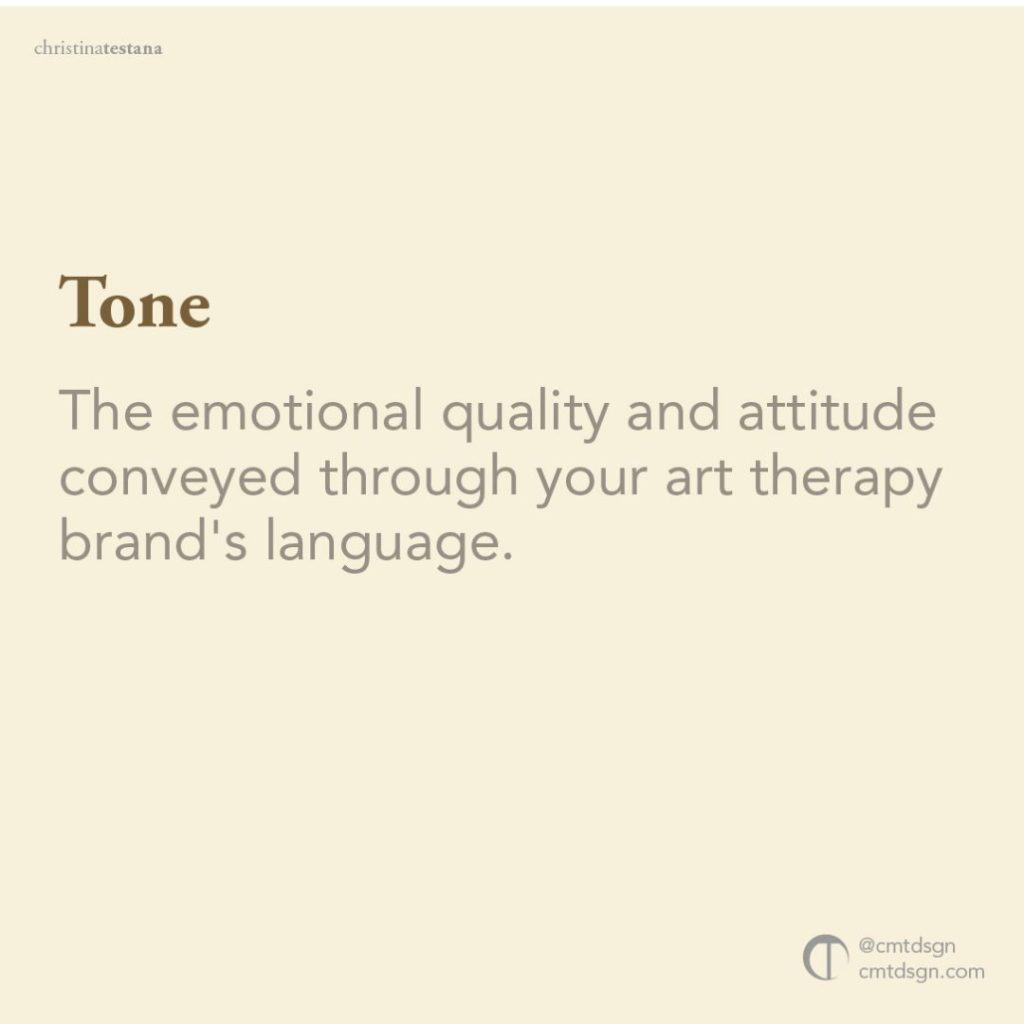
Tone: This refers to the emotional quality and attitude conveyed through your art therapy brand’s language. Identify if the brand’s tone is formal, casual, friendly, authoritative, humorous, or empathetic? The tone should align with the brand’s personality and what your ideal client expects the brand to sound. Identify the emotions it aims to embody.
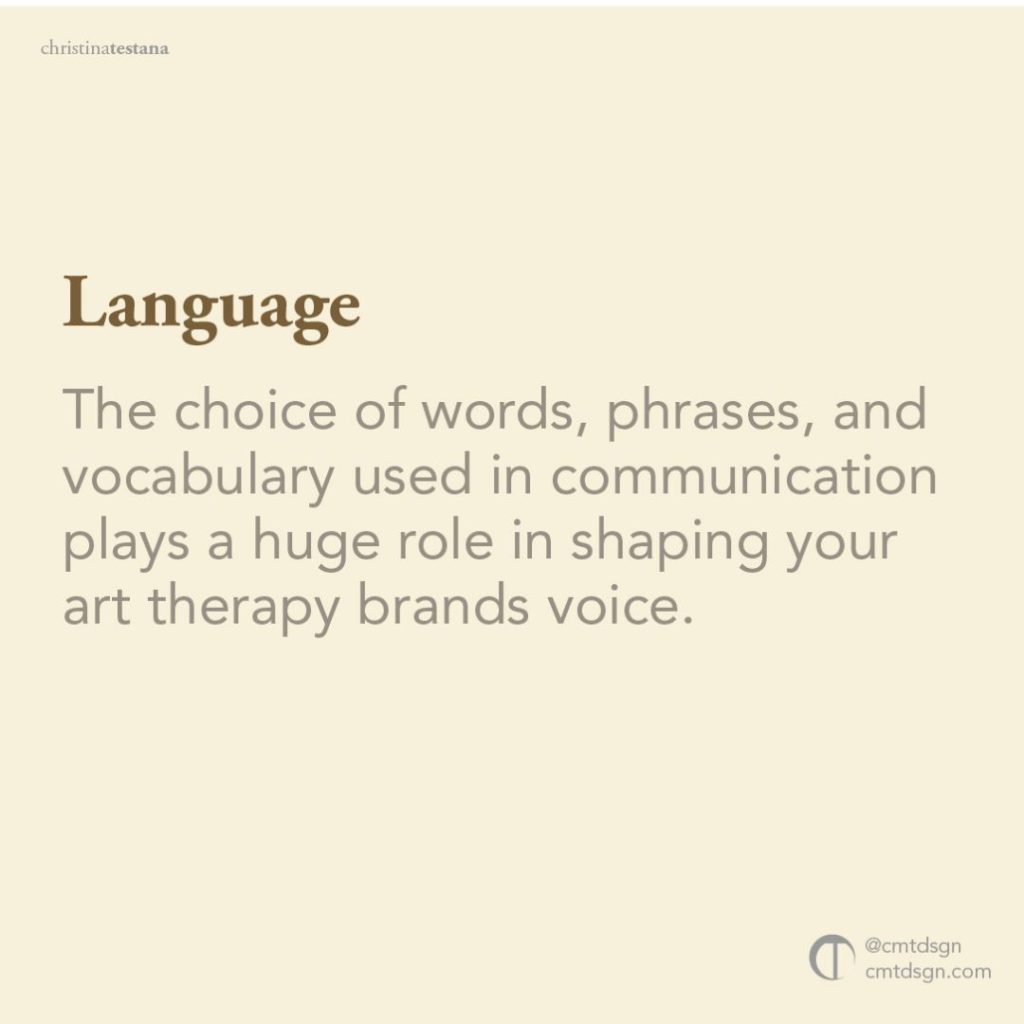
Language: The choice of words, phrases, and vocabulary used in communication plays a huge role in shaping your art therapy brands voice. Some art therapy brands might use technical jargon, while others might prefer for simple and approachable language.
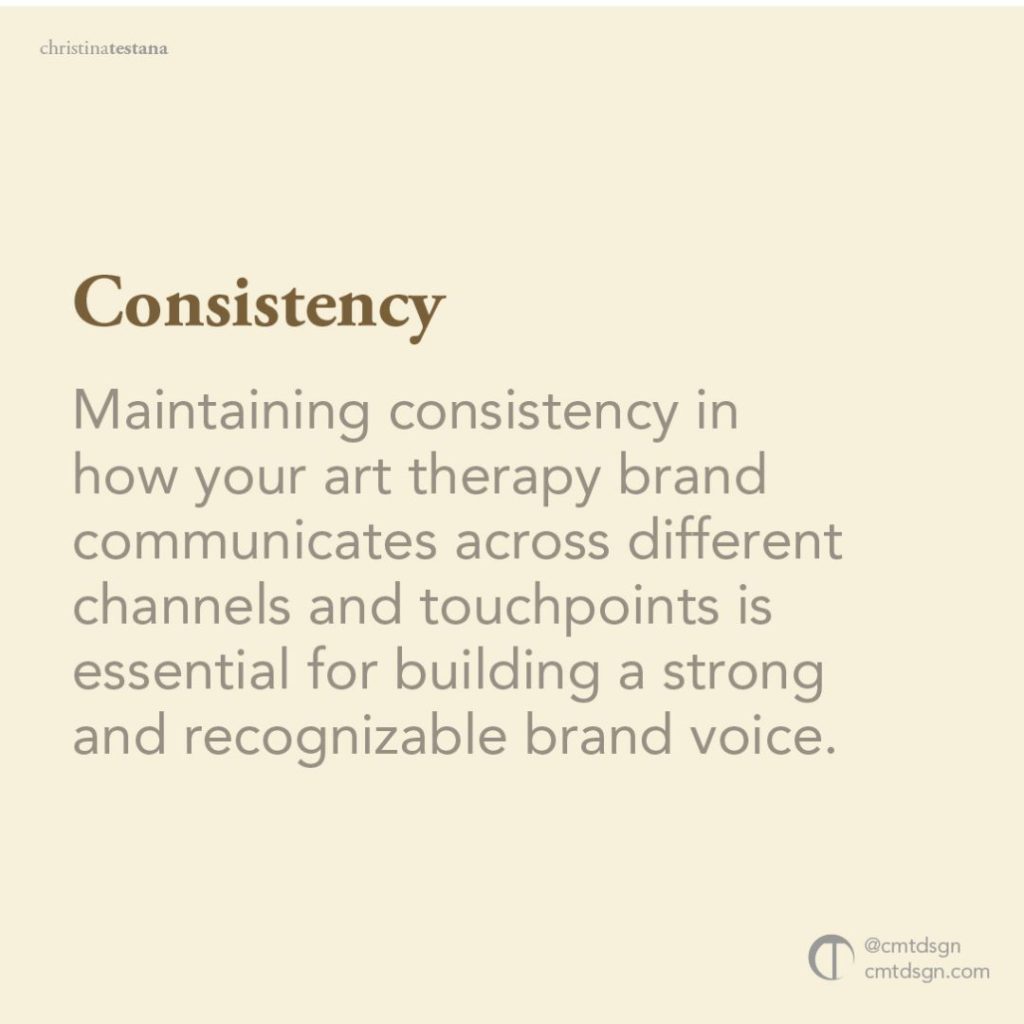
Consistency: Maintaining consistency in how your art therapy brand communicates across different channels and touchpoints is essential for building a strong and recognizable brand voice. Inconsistencies can confuse the audience and dilute your art therapy brand’s identity.
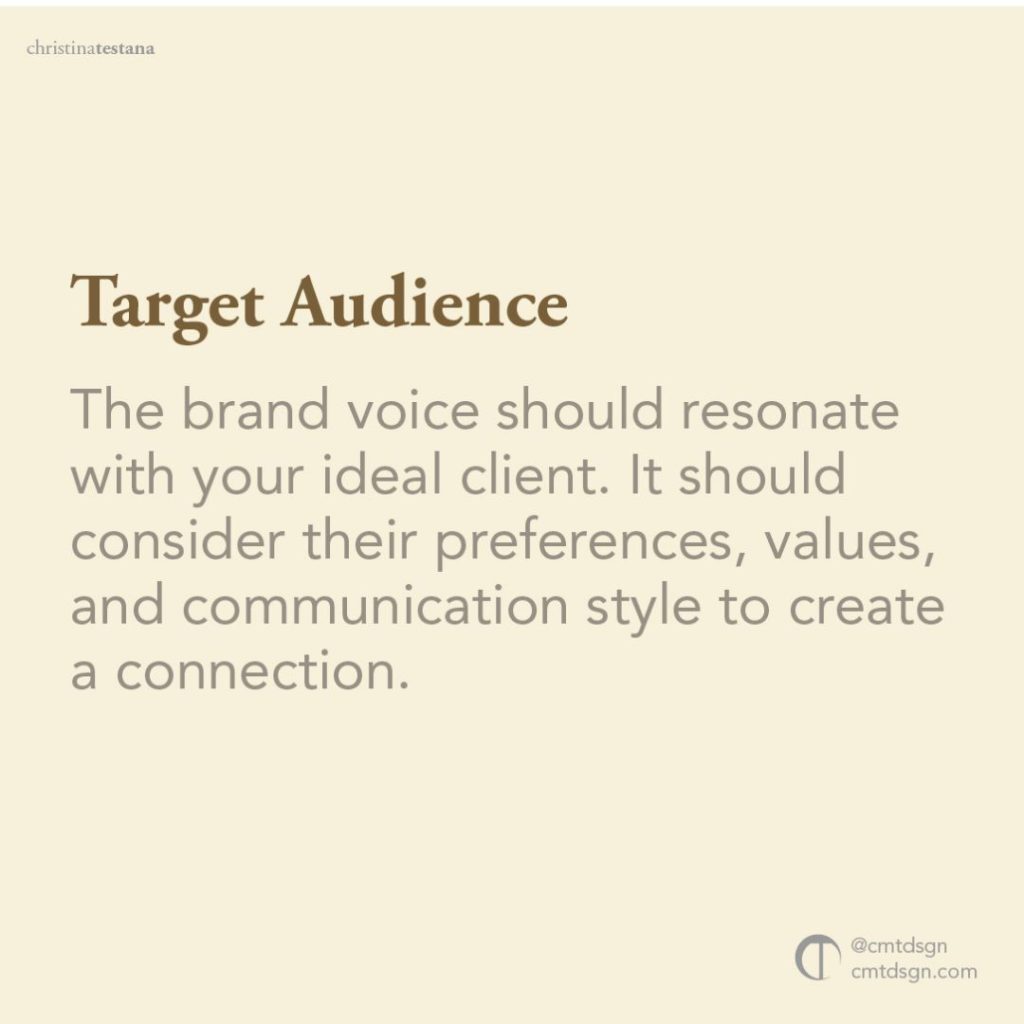
Target Audience: The brand voice should resonate with your ideal client. It should consider their preferences, values, and communication style to create a connection.
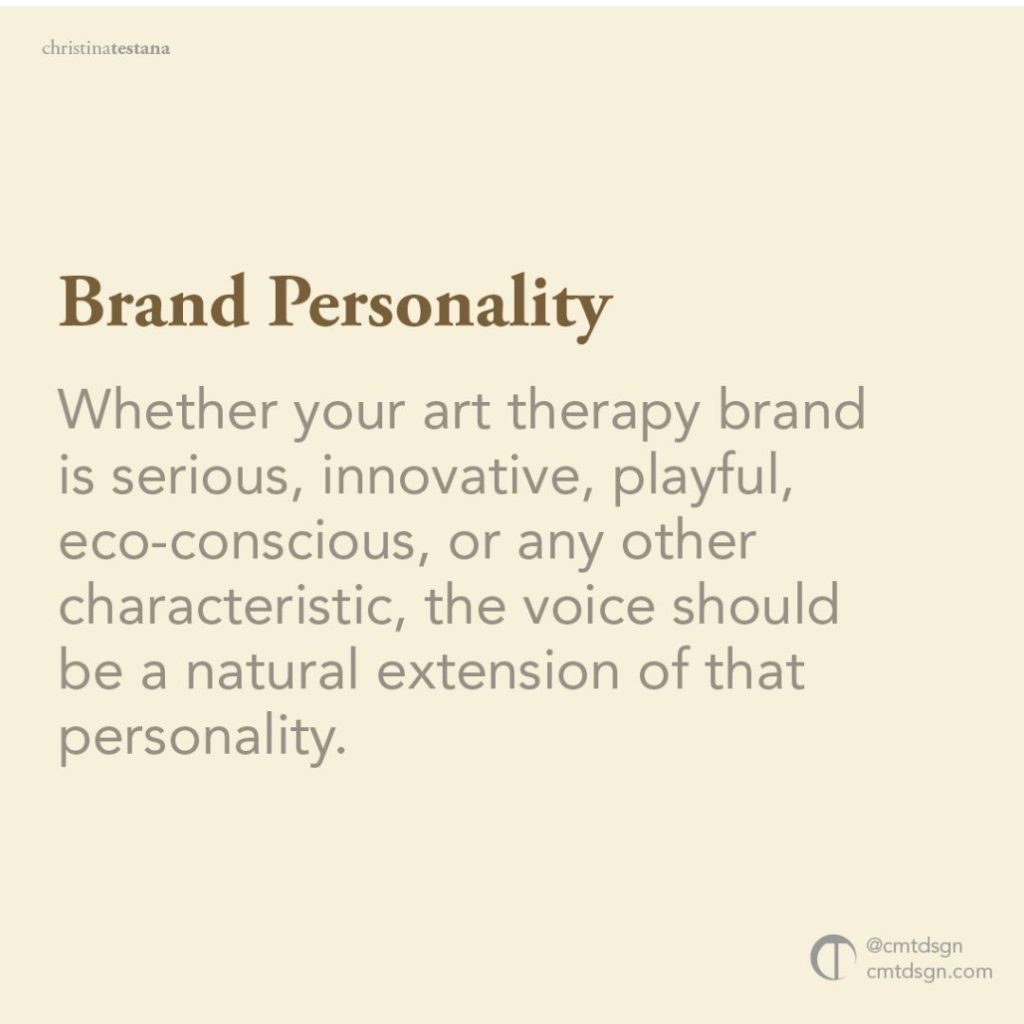
Brand Personality: The brand voice should reflect the overall personality and values of your art therapy brand. Whether your art therapy brand is serious, innovative, playful, eco-conscious, or any other characteristic, the voice should be a natural extension of that personality.
Context: Different communication contexts may require variations in the brand voice. For example, your art therapy brand you might adopt a more formal tone in official announcements and a more casual tone on social media platforms.
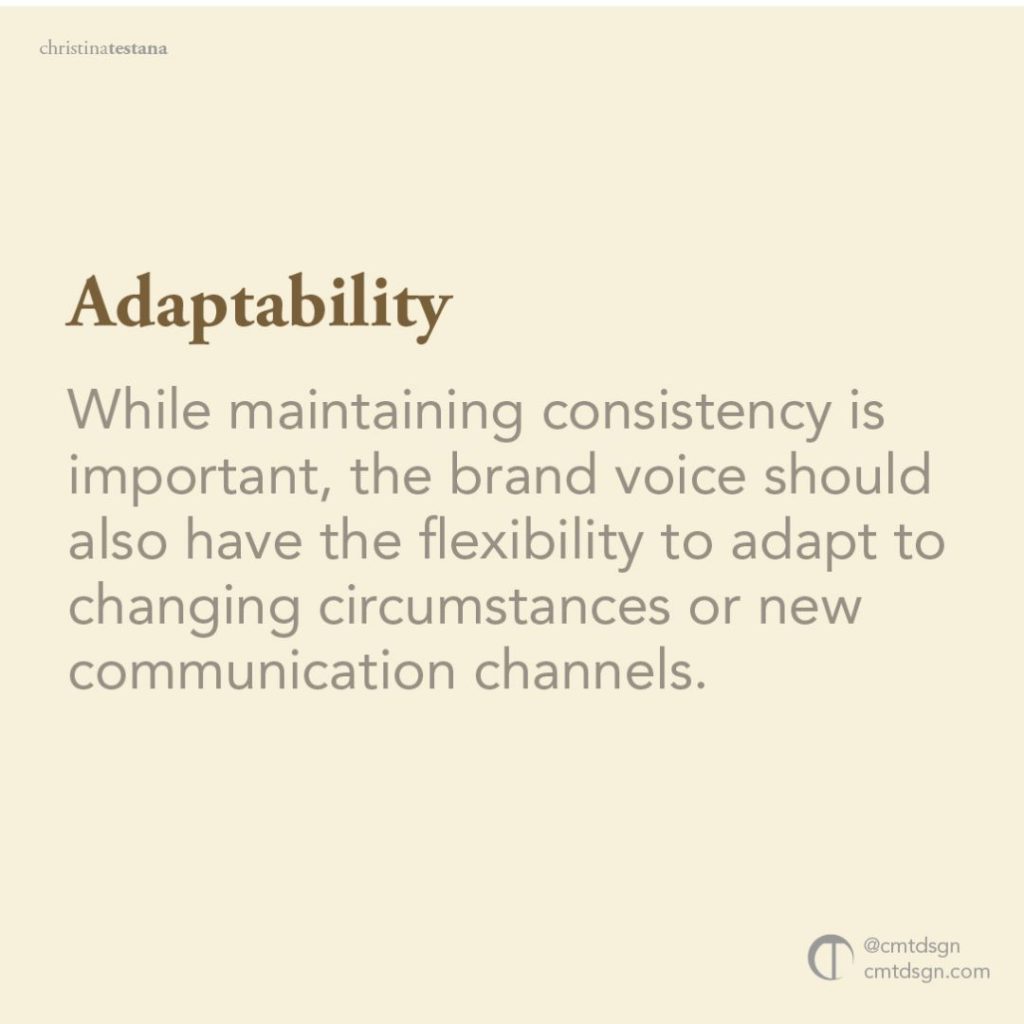
Adaptability: While maintaining consistency is important, the brand voice should also have the flexibility to adapt to changing circumstances or new communication channels.
Creating and refining a brand voice involves a deep understanding of the brand’s identity, its ideal client, and the competitive landscape. It requires careful consideration and ongoing monitoring to ensure that the voice remains relevant and effective over time.
Authenticity and its Impact
The role of authenticity in building trust and connection:
We all know that when you be your honest self, you create genuine connections with individuals. This is essential in the realms of branding because you are building relationships with people. If you are looking for building trust with your people, it starts with communicating authentically, transparently and honesty. People are drawn to art therapy brands that showcase their true and real values, beliefs, and personality rather than trying to create a persona that is not theirs. People will see past the mask if you try to impersonate someone you are not. Being authentic in communication allows you and your art therapy brand to engage on a deeper level that people can relate to and resonate with on your art therapy brand’s genuine story. People connect with other peoples stories so be sure they are real.
How an authentic brand voice attracts like-minded individuals:
Using your real voice that you emulate on the daily is your authentic brand voice. This approach to your brand voice will act like a magnet for individuals who share similar values and beliefs. When your art therapy brand communicates in a way that aligns with your ideal clients perspective, it creates a sense of belonging and companionship that holds shared experiences, challenges, or values. Here’s a important thing to remember, like-minded individuals are drawn to art therapy brands that reflect their own identity and aspirations. This is how to create a loyal community that turn into advocates and enthusiasts of you and your work. In the end, helping you achieve growth and success.
Professionalism for Art Therapists
Importance of maintaining a professional yet genuine image:
In the field of art therapy, maintaining a professional but yet genuine image is essential for several reasons. Firstly, it brings confidence in clients and peers, assuring them that you are qualified and reliable. A professional yet genuine ****manner also contributes to the credibility of the entire art therapy profession. A professional yet genuine image can lead to increased referrals, as satisfied clients are more likely to recommend your services. Additionally, it sets the tone for the therapeutic relationship, creating an environment of respect and trust.
Balancing professionalism with personal expression:
Art therapists often deal with the challenge of balancing professionalism with personal expression. While maintaining a professional boundary is essential, integrating personal expression can actually enhance the therapeutic process. Sharing relatable aspects of your personal experiences or creative journey can help clients feel more comfortable and understood. The key lies in the strategy in what to share and when, ensuring that it contributes positively to the therapeutic dynamic without overshadowing the client’s needs.
For example of sharing a story: In my therapy journey, I am currently working with a stress coach on some personal issues regarding family. My coach noticed that I was a struggling to open up about a few things. Then out of the blue, he shares a personal story about his experience of family and I was so shocked by the story and how similar we both were in feeling misunderstood or not fully accepted. This made me feel much more comfortable in sharing what was on my mind, and some how in that moment we both harmonized.
Steps to Develop a Consistent Brand Voice
Discovering Your Art Therapy Identity
Self-assessment
This is called the inside-out approach when it comes to designing a brand that is authentic focused. What personal values and qualities define you as an art therapist? Take time to do some introspection work to identify the core values, principles, and qualities that define your approach to art therapy. Starting at the core and getting to know the real you helps to create a strong aligned art therapy brand that is effortless.
If you are struggling to know what you value or your principles look to the Myers Briggs MBTI test to gain some clarity in your personality type. This gives you a framework to start from. Another thing you can do is look to your friends and family and see through their perspective of you in terms of what you value and your principles. You’ll be surprised in what shows up.
Identifying your unique strengths and perspectives
This activity will require you to do some journalling. Reflect on your unique skills, experiences, and perspectives that contribute to your effectiveness as an art therapist. These could be your artistic abilities, empathy, communication skills, or specific areas of expertise.
Defining Your Ideal Client:
Your art therapy brand has to speak to a specific person an not be generalized. It’s essential to understand your ideal client, here are a few ways to start:
- Look to your current client base and see if there is anyone who specifically stands out to you that you want more of. Create a ideal client profile based on someone you loved working with or someone in your inner circle. Gather data about them to build the profile.
- Conduct research to comprehend the needs, wants, pain points, goals, desires, aspirations, and challenges they might be currently facing
- Run interviews with 5 ideal clients from your client base or network or with people you found on Instagram that match your ideal client profile.
Once you have an idea of the client you want to attract, it learning about what voice do they expect from you.
Tailoring brand voice to meet ideal clients needs:
Develop a communication style that speaks directly to your ideal client. Use language, tone, and messaging that resonate with their goals and emotions.
From here you need to create a word and phrase bank or library that you can refer too every time you have to write something or interact with someone. This will be your cheat sheet to help you with staying consistent.
Crafting an Authentic Brand Message:
Clearly define WHY you are starting this art therapy business:
Explain your passion about art therapy and how you want to make a positive impact. It all starts here, it’s the fuel to creating a lasting art therapy brand.
With any messaging you need to keep this personal why in mind when writing, speaking etc. When passion is shown through the brand voice people will feel moved by it and want to be apart of the movement.
Alignment with art therapy:
You job here as an art therapy brand and art therapist is to educate and captivate through storytelling. Connect your personal story to your brand and strengthen your brand message with painting the picture of the transformative power of art therapy.
Highlight how your approach aligns with the potential for healing, self-discovery, and personal growth through artistic expression. People struggle to see how art therapy works, and you need to use your artistic abilities to illustrate what that looks like, feels like and sounds like to them.
The more things you can show the better and more receptive your ideal client will be towards trying art therapy.
Building a Community of Value
Building an art therapy brand revolves around community, that is how your art therapy brand will stay alive. It’s key to nurturing connections with your ideal client but also fellow therapists or other professionals that compliment your services.
Emphasize the importance of building relationships with both colleagues and clients. To acknowledge a sense of community where everyone feels supported and valued.
The impact of a supportive art therapy community leads to collaborative opportunities that you couldn’t achieve alone. You have the opportunity to create with another collaborator an offer or a bundle that is holistically going to bring amazing changes to your ideal client.
They will appreciate that in the end. People love when others come together to create a masterpiece. It’s best to look at your competitors as allies because you are working as a team to help your ideal client and this can be in resource-sharing or doing a special event together that collectively you both grow together in the art therapy field.
Consistency Across Platforms
Ensuring a consistent brand voice across your website, social media, and interactions:
Your brand voice need to be the same across all platforms, for people to recognize you and it’s not someone else writing for you. The more you systemize your brand voice the better you will sound and look put together and professional. Consistency builds recognition and trust among your audience.
Using visuals and language to reinforce your brand identity:
Words and visuals work hand in hand you can’t have one without the other. Visual elements, such as logos and colour schemes, along with consistent language choices, contribute to a strong and recognizable brand identity. Be sure that your brand voice also connects with the energy your visuals radiate.
Evolving Your Brand Voice
Embracing evolution while maintaining core brand values: As you grow and expand your art therapy brand, it’s keep to do house keeping on your brand foundation. Your brand voice is part of that foundation and can evolve over time while still staying true to your core values. With the changes its important to adapt to changes in the industry and audience preferences. It’s never a one and done thing you have to keep going back every quarter to adjust your brand blueprint/ brand foundation.
Adapting to the changing needs of your community: I encourage you to stay engaged with your target audiences changing needs and preferences. You can do this by regularly running feedback sessions and adjusting your brand voice accordingly.
Crafting Your Art Therapy Symphony
In the grand tapestry of art therapy, where colours of authenticity and professionalism weave together, you hold the brush that paints your unique masterpiece. As an art therapist, your journey isn’t just about helping others express themselves through creativity—it’s also about unveiling your true self to the world.
By harmonizing authenticity and professionalism, you’ve created a brand voice that’s as vivid as the strokes on a canvas. Your words, your tone, and your style resonate with both the hearts of those you assist and the standards of your profession.
Remember that your brand voice is a living creation.
Just like the evolving landscapes of art, your voice will adapt and grow while staying rooted in your core values. As your art therapy community flourishes, you’ll continue to learn, share, and inspire—a symphony of transformation in every interaction.
So, step forward confidently, armed with the balance of authenticity and professionalism. Your art therapy brand voice, shaped by your true essence and guided by your expertise, will continue to make a profound impact on the lives you touch. As you speak, write, and connect, your unique melody will resonate, leaving an impeccable mark on the canvas of every heart you encounter. 🌈🎉
